
qserve
QServe: W4A8KV4 Quantization and System Co-design for Efficient LLM Serving
Stars: 383
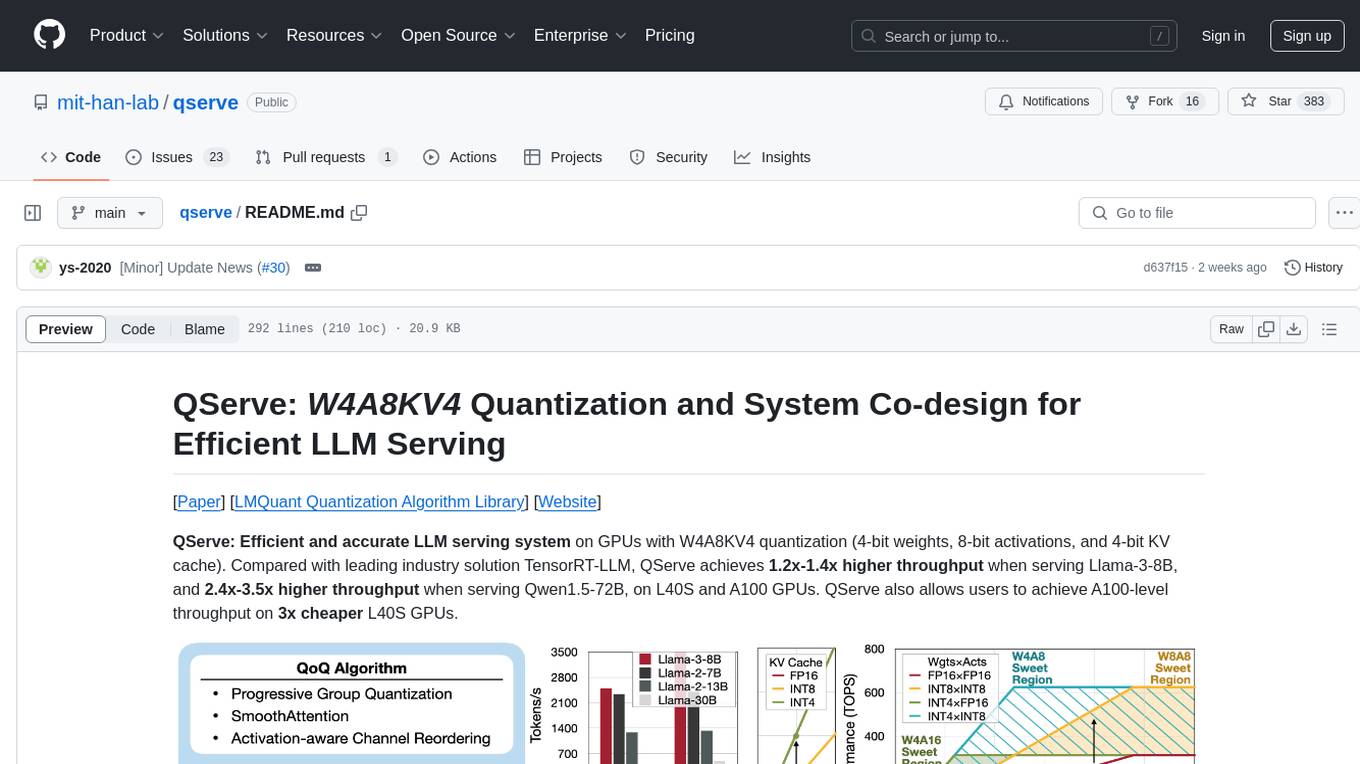
QServe is a serving system designed for efficient and accurate Large Language Models (LLM) on GPUs with W4A8KV4 quantization. It achieves higher throughput compared to leading industry solutions, allowing users to achieve A100-level throughput on cheaper L40S GPUs. The system introduces the QoQ quantization algorithm with 4-bit weight, 8-bit activation, and 4-bit KV cache, addressing runtime overhead challenges. QServe improves serving throughput for various LLM models by implementing compute-aware weight reordering, register-level parallelism, and fused attention memory-bound techniques.
README:
[Paper] [LMQuant Quantization Algorithm Library] [Website]
QServe: Efficient and accurate LLM serving system on GPUs with W4A8KV4 quantization (4-bit weights, 8-bit activations, and 4-bit KV cache). Compared with leading industry solution TensorRT-LLM, QServe achieves 1.2x-1.4x higher throughput when serving Llama-3-8B, and 2.4x-3.5x higher throughput when serving Qwen1.5-72B, on L40S and A100 GPUs. QServe also allows users to achieve A100-level throughput on 3x cheaper L40S GPUs.
Quantization can accelerate large language model (LLM) inference. Going beyond INT8 quantization, the research community is actively exploring even lower precision, such as INT4. Nonetheless, state-of-the-art INT4 quantization techniques only accelerate low-batch, edge LLM inference, failing to deliver performance gains in large-batch, cloud-based LLM serving. We uncover a critical issue: existing INT4 quantization methods suffer from significant runtime overhead (20-90%) when dequantizing either weights or partial sums on GPUs. To address this challenge, we introduce QoQ, a W4A8KV4 quantization algorithm with 4-bit weight, 8-bit activation, and 4-bit KV cache. QoQ stands for quattuor-octo-quattuor, which represents 4-8-4 in Latin. QoQ is implemented by the QServe inference library that achieves measured speedup. The key insight driving QServe is that the efficiency of LLM serving on GPUs is critically influenced by operations on low-throughput CUDA cores. Building upon this insight, in QoQ algorithm, we introduce progressive quantization that can allow low dequantization overhead in W4A8 GEMM. Additionally, we develop SmoothAttention to effectively mitigate the accuracy degradation incurred by 4-bit KV quantization. In the QServe system, we perform compute-aware weight reordering and take advantage of register-level parallelism to reduce dequantization latency. We also make fused attention memory-bound, harnessing the performance gain brought by KV4 quantization. As a result, QServe improves the maximum achievable serving throughput of Llama-3-8B by 1.2× on A100, 1.4× on L40S; and Qwen1.5-72B by 2.4× on A100, 3.5× on L40S, compared to TensorRT-LLM. Remarkably, QServe on L40S GPU can achieve even higher throughput than TensorRT-LLM on A100. Thus, QServe effectively reduces the dollar cost of LLM serving by 3×.
The current release supports:
- Blazingly fast system support for QoQ W4A8KV4 quantization (Algorithim release: LMQuant);
- Pre-quantized QServe model zoo with W4A8KV4 QoQ for mainstream LLMs;
- Fully PyTorch-based runtime and user interface for LLM serving, with TensorRT-LLM-level efficiency and PyTorch-level flexibility;
- Full support for in-flight batching and paged attention;
- Efficient fused CUDA kernels for W4A8/W8A8 GEMM and KV4/KV8 attention;
- Easy-to-use examples on speed benchmarking and large-scale end-to-end content generation (with W4A8KV4, in-flight batching and paged attention).
- [2024/07] QServe W4A8 GEMM kernels source code now available!
- [2024/05] 🔥 QServe is publicly released! Check our paper here.
- Clone this repository and navigate to the corresponding folder:
git clone https://github.com/mit-han-lab/qserve
cd qserve
- Install QServe
conda create -n QServe python=3.10 -y
conda activate QServe
pip install --upgrade pip # enable PEP 660 support
pip install -e .
pip install flash-attn --no-build-isolation
We recommend starting an interactive python CLI interface and run
import flash_attnto check whether FlashAttention-2 is installed successfully. If not, we recommend downloading pre-built wheels from here. Please notice:
- PyTorch version needs to exactly match with the version specified in the
.whlname; - Check out both
cxx11abiTRUEandcxx11abiFALSEwheels if one of them does not work; - It's recommended to match CUDA version specified in the
.whlfilename, but minor mismatches (e.g. 12.1 vs 12.2, or even 11.8 vs 12.2) usually do not matter.
- Compile the CUDA kernels.
cd kernels
python setup.py install
- If you want to clone our model zoo, please make sure that
git-lfsis installed.
We provide pre-quantized checkpoints for multiple model families. For example, for Llama-3-8B model, please run the following commands to download:
# git lfs install # install git lfs if not already
mkdir -p qserve_checkpoints && cd qserve_checkpoints
git clone https://huggingface.co/mit-han-lab/Llama-3-8B-QServe For other models, please refer to the detailed support list for the links to download:
| Models | W4A8-per-channel | W4A8-g128 |
|---|---|---|
| Llama3 | ✅ 8B/70B | ✅ 8B/70B |
| Llama3-Instruct | ✅ 8B/70B | ✅ 8B/70B |
| Llama2 | ✅ 7B/13B/70B | ✅ 7B/13B/70B |
| Vicuna | ✅ 7B/13B/30B | ✅ 7B/13B/30B |
| Mistral | ✅ 7B | ✅ 7B |
| Yi | ✅ 34B | ✅ 34B |
| Qwen | ✅ 72B | ✅ 72B |
For flagship datacenter GPUs such as the A100, it is recommended to use QServe-per-channel, while for inference datacenter GPUs like the L40S, QServe-per-group is the recommended approach.
If you are interested in generating the quantized checkpoints on your own, please follow the instructions in LMQuant to run QoQ quantization and dump the fake-quantized models. We then provide checkpoint converter to real-quantize and pack the model into QServe format:
python checkpoint_converter.py --model-path <hf-model-path> --quant-path <fake-quant-model-path> --group-size -1 --device cpu
# <fake-quant-model-path> is a directory generated by LMQuant, including model.pt and scale.ptWe also provide a script to run the checkpoint converter. The final model will be automatically stored under qserve_checkpoints.
We support both offline benchmarking and online generation (in-flight-batching) in QServe.
- Offline speed benchmarking (Batched input sequences, fixed context length = 1024 and generation length = 512). We take Llama-3-8B (per-channel quant) as an example here. Please make sure that you have already downloaded the QoQ-quantized QServe model.
export MODEL_PATH=./qserve_checkpoints/Llama-3-8B-QServe # Please set the path accordingly
GLOBAL_BATCH_SIZE=128 \
python qserve_benchmark.py \
--model $MODEL_PATH \
--benchmarking \
--precision w4a8kv4 \
--group-size -1If you hope to use larger batch sizes such as 256, you may need to change NUM_GPU_PAGE_BLOCKS to a larger value than the automatically-determined value on A100. For example:
export MODEL_PATH=./qserve_checkpoints/Llama-3-8B-QServe # Please set the path accordingly
GLOBAL_BATCH_SIZE=256 \
NUM_GPU_PAGE_BLOCKS=6400 \
python qserve_benchmark.py \
--model $MODEL_PATH \
--benchmarking \
--precision w4a8kv4 \
--group-size -1- This is an online demonstration of batched generation, showcasing in-flight batching, paged attention of W4A8KV4 QoQ LLMs. We will randomly sample a set of safety-moderated conversations from the WildChat dataset and process them efficiently through in-flight batching.
export MODEL_PATH=./qserve_checkpoints/Llama-3-8B-Instruct-QServe # Please set the path accordingly
python qserve_e2e_generation.py \
--model $MODEL_PATH \
--ifb-mode \
--precision w4a8kv4 \
--quant-path $MODEL_PATH \
--group-size -1-
Argument list in QServe
Below are some frequently used arguments in QServe interface:
-
--model: Path to the folder containing hf model configs. Can be the same as--quant-pathif you directly download the models from QServe model zoo. -
--quant-path: Path to the folder containing quantized LLM checkpoints. -
--precision: The precision for GEMM in QServe, please choose from the following values:w4a8kv4,w4a8kv8,w4a8(meansw4a8kv8),w8a8kv4,w8a8kv8,w8a8(meansw8a8kv8). Default:w4a8kv4. -
--group-size: Group size for weight quantization, -1 means per-channel quantization. QServe only supports -1 or 128. Please make sure your group size matches the checkpoint. -
--max-num-batched-tokens: Maximum number of batched tokens per iteration. Default: 262144. -
--max-num-seqs: Maximum number of sequences per iteration. Default: 256. Remember to increase it if you want larger batch sizes. -
--ifb-mode: Enable in-flight batching mode. Suggest to activate in e2e generation. -
--benchmarking: Enable speed profiling mode. Benchmark settings aligned with TensorRT-LLM.Environment variables in QServe:
-
GLOBAL_BATCH_SIZE: Batch size used in offline speed benchmarking. -
NUM_GPU_PAGE_BLOCKS: Number of pages to be allocated on GPU. If not specified, it will be automatically determined based on available GPU memory. Note that the current automatic GPU page allocation algorithm is very conservative. It is recommended to manually set this value to a larger number if you observe that GPU memory utilization is relatively low.
- One-line scripts:
We also provide sample scripts in QServe.
- End to end generation:
./scripts/run_e2e.sh; - Speed benchmarking:
./scripts/benchmark/benchmark_a100.shor./scripts/benchmark/benchmark_l40s.sh.
These scripts are expected to be executed in the QServe project folder (not in the scripts folder). Please note that git-lfs is needed for downloading QServe benchmark config files from huggingface before running the benchmark scripts.
We evaluate QServe W4A8KV4 quantization on a wide range of mainstream LLMs. QServe consistently outperforms existing W4A4 or W4A8 solutions from the accuracy perspective, while providing State-of-the-Art LLM serving efficiency.
When serving the large language models Llama-3-8B and Qwen1.5-72B on L40S and A100 GPUs, QServe demonstrates superior performance, achieving 1.2x-1.4x higher throughput compared to the leading industry solution, TensorRT-LLM, for Llama-3-8B, and a 2.4x-3.5x higher throughput for Qwen1.5-72B. It is also able to deliver higher throughput and accomodate the same batch size on L40S compared with TensorRT-LLM on A100 for six of eight models benchmarked, effectively saving the dollar cost of LLM serving by around 3x.
Benchmarking setting: the criterion is maximum achieveable throughput on NVIDIA GPUs, and the input context length is 1024 tokens, output generation length is 512 tokens. For all systems that support paged attention, we enable this feature. In-flight batching is turned off in the efficiency benchmarks.
| L40S (48G) | Llama-3-8B | Llama-2-7B | Mistral-7B | Llama-2-13B | Llama-30B | Yi-34B | Llama-2-70B | Qwen-1.5-72B |
|---|---|---|---|---|---|---|---|---|
| TRT-LLM-FP16 | 1326 | 444 | 1566 | 92 | OOM | OOM | OOM | OOM |
| TRT-LLM-W4A16 | 1431 | 681 | 1457 | 368 | 148 | 313 | 119 | 17 |
| TRT-LLM-W8A8 | 2634 | 1271 | 2569 | 440 | 123 | 364 | OOM | OOM |
| Atom-W4A4 | -- | 2120 | -- | -- | -- | -- | -- | -- |
| QuaRot-W4A4 | -- | 805 | -- | 413 | 133 | -- | -- | 15 |
| QServe-W4A8KV4 | 3656 | 2394 | 3774 | 1327 | 504 | 869 | 286 | 59 |
| Throughput Increase* | 1.39x | 1.13x | 1.47x | 3.02x | 3.41x | 2.39x | 2.40x | 3.47x |
| A100 (80G) | Llama-3-8B | Llama-2-7B | Mistral-7B | Llama-2-13B | Llama-30B | Yi-34B | Llama-2-70B | Qwen-1.5-72B |
|---|---|---|---|---|---|---|---|---|
| TRT-LLM-FP16 | 2503 | 1549 | 2371 | 488 | 80 | 145 | OOM | OOM |
| TRT-LLM-W4A16 | 2370 | 1549 | 2403 | 871 | 352 | 569 | 358 | 143 |
| TRT-LLM-W8A8 | 2396 | 2334 | 2427 | 1277 | 361 | 649 | 235 | 53 |
| Atom-W4A4 | -- | 1160 | -- | -- | -- | -- | -- | -- |
| QuaRot-W4A4 | -- | 1370 | -- | 289 | 267 | -- | -- | 68 |
| QServe-W4A8KV4 | 3005 | 2908 | 2970 | 1741 | 749 | 803 | 419 | 340 |
| Throughput Increase* | 1.20x | 1.25x | 1.22x | 1.36x | 2.07x | 1.23x | 1.17x | 2.38x |
The absolute token generation throughputs of QServe and baseline systems (Unit: tokens/second. -- means unsupported). All experiments were
conducted under the same device memory budget. Throughput increase of QServe is calculated with regard to the best baseline in each column. It is recommended to use QServe-per-channel on high-end datacenter GPUs like A100 and QServe-per-group is recommended on inference GPUs like L40S.
Max throughput batch sizes used by QServe:
| Device | Llama-3-8B | Llama-2-7B | Mistral-7B | Llama-2-13B | Llama-30B | Yi-34B | Llama-2-70B | Qwen-1.5-72B |
|---|---|---|---|---|---|---|---|---|
| L40S | 128 | 128 | 128 | 75 | 32 | 64 | 24 | 4 |
| A100 | 256 | 190 | 256 | 128 | 64 | 196 | 96 | 32 |
We recommend direcly setting the NUM_GPU_PAGE_BLOCKS environmental variable to 25 * batch size, since in our benchmarking setting we have a context length of 1024 and generation length of 512, which corresponds to 24 pages (each page contains 64 tokens). We leave some buffer by allocating one more page for each sequence.
QServe also maintains high accuracy thanks to the QoQ algorithm provided in our LMQuant quantization library.
Below is the WikiText2 perplexity evaluated with 2048 sequence length. The lower is the better.
| Models | Precision | Llama-3 8B | Llama-2 7B | Llama-2 13B | Llama-2 70B | Llama 7B | Llama 13B | Llama 30B | Mistral 7B | Yi 34B |
|---|---|---|---|---|---|---|---|---|---|---|
| FP16 | 6.14 | 5.47 | 4.88 | 3.32 | 5.68 | 5.09 | 4.10 | 5.25 | 4.60 | |
| SmoothQuant | W8A8 | 6.28 | 5.54 | 4.95 | 3.36 | 5.73 | 5.13 | 4.23 | 5.29 | 4.69 |
| GPTQ-R | W4A16 g128 | 6.56 | 5.63 | 4.99 | 3.43 | 5.83 | 5.20 | 4.22 | 5.39 | 4.68 |
| AWQ | W4A16 g128 | 6.54 | 5.60 | 4.97 | 3.41 | 5.78 | 5.19 | 4.21 | 5.37 | 4.67 |
| QuaRot | W4A4 | 8.33 | 6.19 | 5.45 | 3.83 | 6.34 | 5.58 | 4.64 | 5.77 | NaN |
| Atom | W4A4 g128 | 7.76 | 6.12 | 5.31 | 3.73 | 6.25 | 5.52 | 4.61 | 5.76 | 4.97 |
| QoQ | W4A8KV4 | 6.89 | 5.75 | 5.12 | 3.52 | 5.93 | 5.28 | 4.34 | 5.45 | 4.74 |
| QoQ | W4A8KV4 g128 | 6.76 | 5.70 | 5.08 | 3.47 | 5.89 | 5.25 | 4.28 | 5.42 | 4.76 |
* SmoothQuant is evaluated with per-tensor static KV cache quantization.
If you find QServe useful or relevant to your research and work, please kindly cite our paper:
@article{lin2024qserve,
title={QServe: W4A8KV4 Quantization and System Co-design for Efficient LLM Serving},
author={Lin*, Yujun and Tang*, Haotian and Yang*, Shang and Zhang, Zhekai and Xiao, Guangxuan and Gan, Chuang and Han, Song},
journal={arXiv preprint arXiv:2405.04532},
year={2024}
}
The QServe serving library is maintained by the following research team:
- Haotian Tang, system lead, MIT EECS;
- Shang Yang, system lead, MIT EECS;
- Yujun Lin, algorithm lead, MIT EECS;
- Zhekai Zhang, system evaluation, MIT EECS;
- Guangxuan Xiao, algorithm evaluation, MIT EECS;
- Chuang Gan, advisor, UMass Amherst and MIT-IBM Watson AI Lab;
- Song Han, advisor, MIT EECS and NVIDIA.
The following projects are highly related to QServe. Our group has developed full-stack application-algorithm-system-hardware support for efficient large models, receiving 9k+ GitHub stars and over 1M Huggingface community downloads.
You are also welcome to check out MIT HAN LAB for other exciting projects on Efficient Generative AI!
-
[Algorithm] LMQuant: Large Foundation Models Quantization
-
[Algorithm] AWQ: Activation-aware Weight Quantization for LLM Compression and Acceleration
-
[System] TinyChat: Efficient and Lightweight Chatbot with AWQ
-
[Application] VILA: On Pretraining of Visual-Language Models
-
[Algorithm] SmoothQuant: Accurate and Efficient Post-Training Quantization for Large Language Models
-
[Algorithm] StreamingLLM: Efficient Streaming Language Models with Attention Sinks
-
[Hardware] SpAtten: Efficient Sparse Attention Architecture with Cascade Token and Head Pruning
We thank Julien Demouth, Jun Yang, and Dongxu Yang from NVIDIA for the helpful discussions. QServe is also inspired by many open-source libraries, including (but not limited to) TensorRT-LLM, vLLM, vLLM-SmoothQuant, FlashAttention-2, LMDeploy, TorchSparse++, GPTQ, QuaRot and Atom.
For Tasks:
Click tags to check more tools for each tasksFor Jobs:
Alternative AI tools for qserve
Similar Open Source Tools

qserve
QServe is a serving system designed for efficient and accurate Large Language Models (LLM) on GPUs with W4A8KV4 quantization. It achieves higher throughput compared to leading industry solutions, allowing users to achieve A100-level throughput on cheaper L40S GPUs. The system introduces the QoQ quantization algorithm with 4-bit weight, 8-bit activation, and 4-bit KV cache, addressing runtime overhead challenges. QServe improves serving throughput for various LLM models by implementing compute-aware weight reordering, register-level parallelism, and fused attention memory-bound techniques.
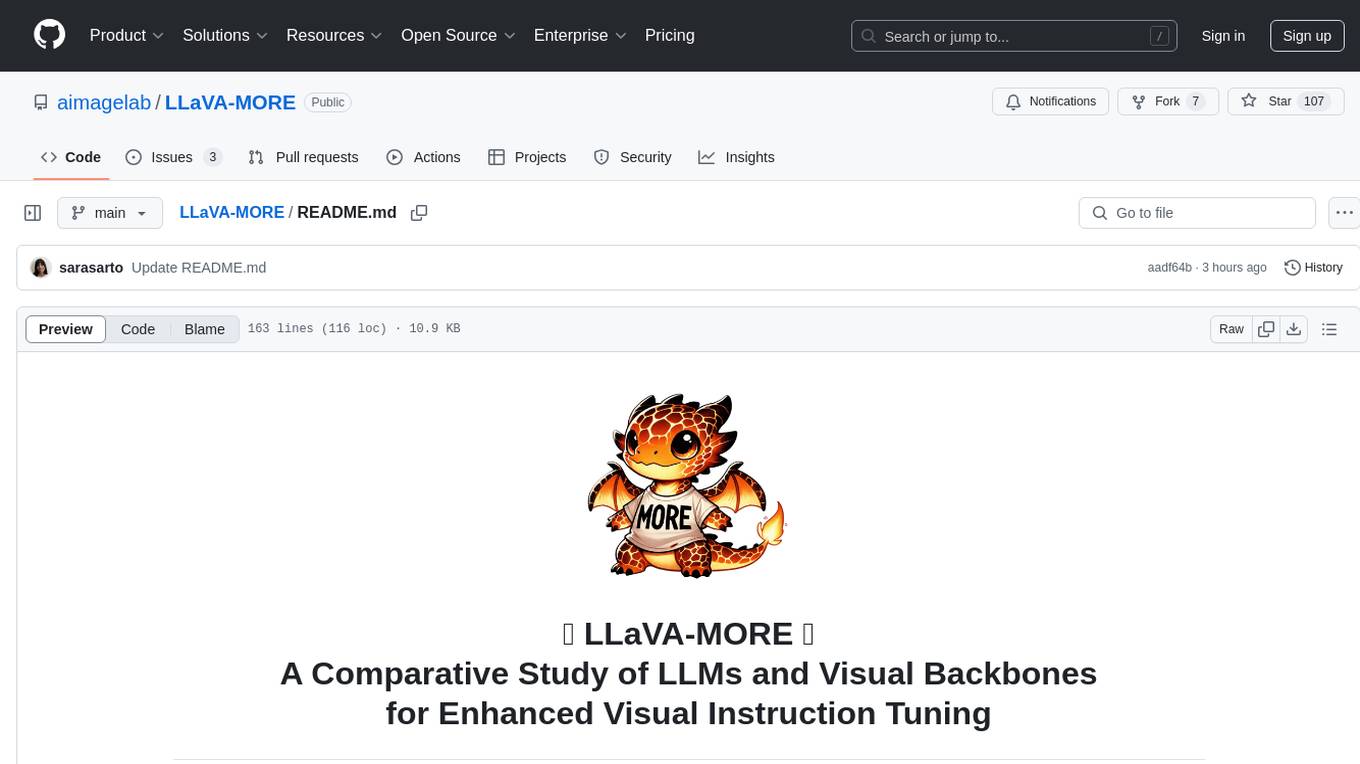
LLaVA-MORE
LLaVA-MORE is a new family of Multimodal Language Models (MLLMs) that integrates recent language models with diverse visual backbones. The repository provides a unified training protocol for fair comparisons across all architectures and releases training code and scripts for distributed training. It aims to enhance Multimodal LLM performance and offers various models for different tasks. Users can explore different visual backbones like SigLIP and methods for managing image resolutions (S2) to improve the connection between images and language. The repository is a starting point for expanding the study of Multimodal LLMs and enhancing new features in the field.
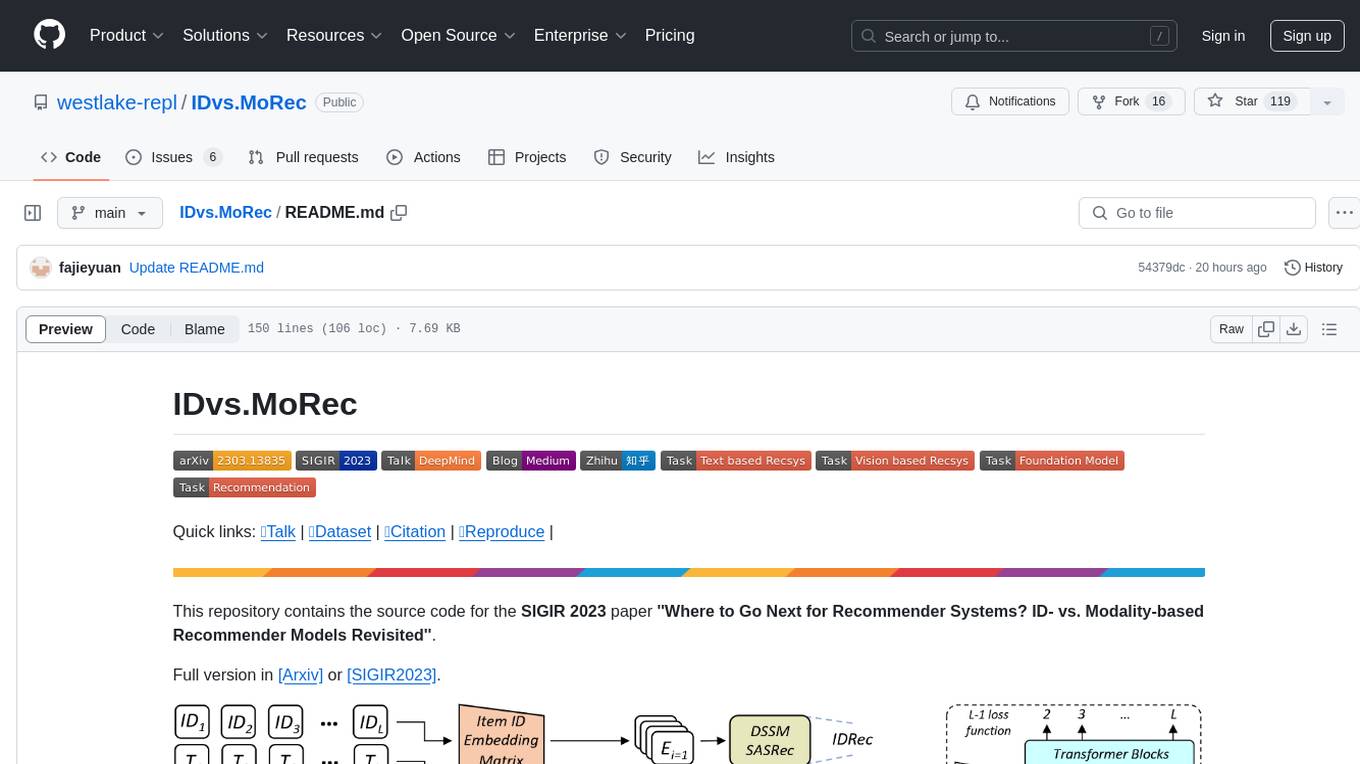
IDvs.MoRec
This repository contains the source code for the SIGIR 2023 paper 'Where to Go Next for Recommender Systems? ID- vs. Modality-based Recommender Models Revisited'. It provides resources for evaluating foundation, transferable, multi-modal, and LLM recommendation models, along with datasets, pre-trained models, and training strategies for IDRec and MoRec using in-batch debiased cross-entropy loss. The repository also offers large-scale datasets, code for SASRec with in-batch debias cross-entropy loss, and information on joining the lab for research opportunities.
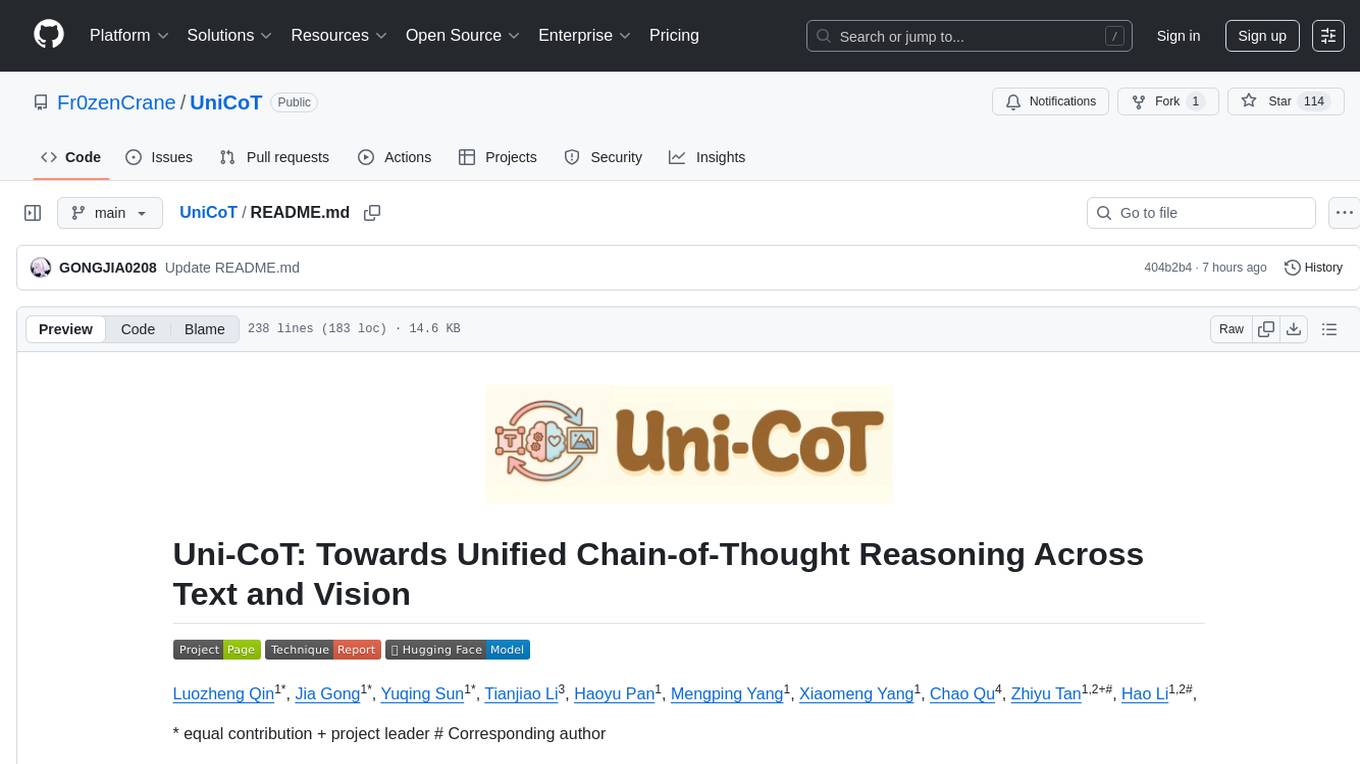
UniCoT
Uni-CoT is a unified reasoning framework that extends Chain-of-Thought (CoT) principles to the multimodal domain, enabling Multimodal Large Language Models (MLLMs) to perform interpretable, step-by-step reasoning across both text and vision. It decomposes complex multimodal tasks into structured, manageable steps that can be executed sequentially or in parallel, allowing for more scalable and systematic reasoning.
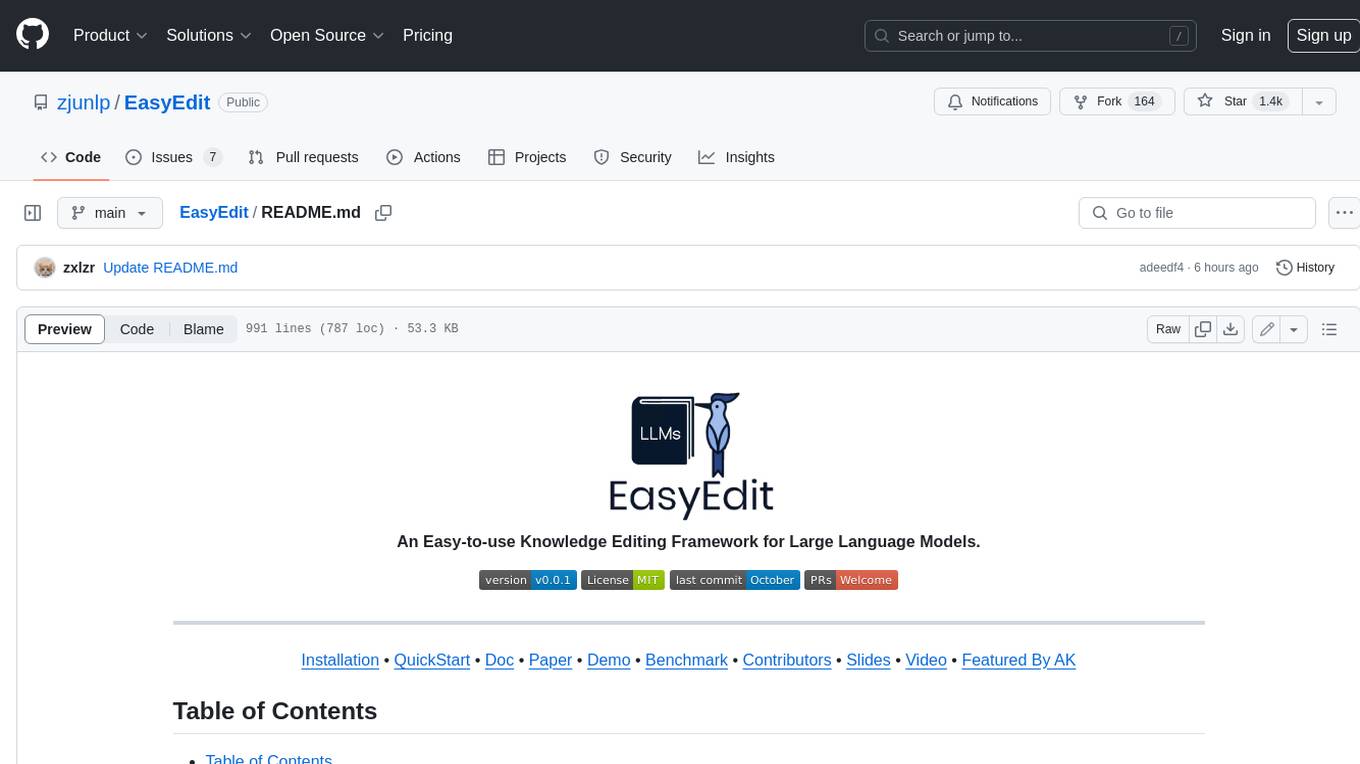
EasyEdit
EasyEdit is a Python package for edit Large Language Models (LLM) like `GPT-J`, `Llama`, `GPT-NEO`, `GPT2`, `T5`(support models from **1B** to **65B**), the objective of which is to alter the behavior of LLMs efficiently within a specific domain without negatively impacting performance across other inputs. It is designed to be easy to use and easy to extend.

StableToolBench
StableToolBench is a new benchmark developed to address the instability of Tool Learning benchmarks. It aims to balance stability and reality by introducing features like Virtual API System, Solvable Queries, and Stable Evaluation System. The benchmark ensures consistency through a caching system and API simulators, filters queries based on solvability using LLMs, and evaluates model performance using GPT-4 with metrics like Solvable Pass Rate and Solvable Win Rate.
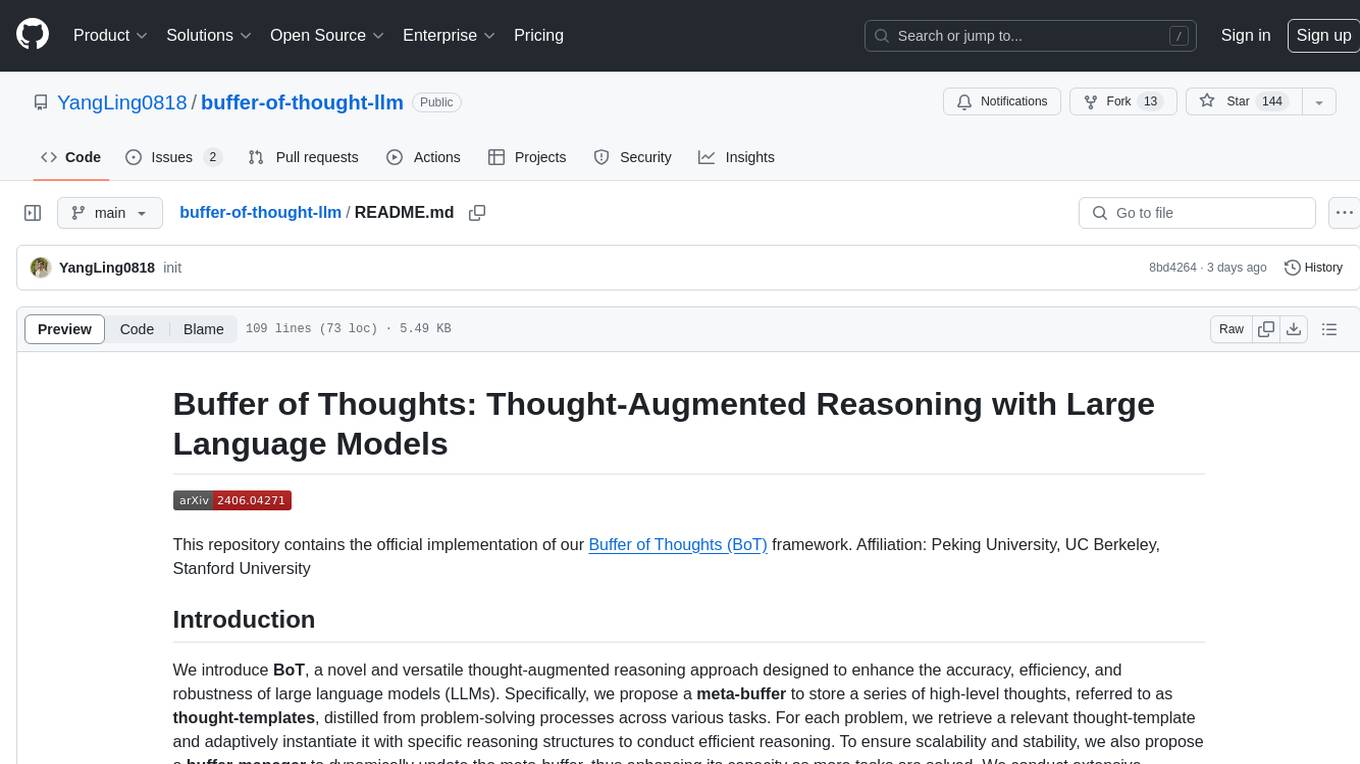
buffer-of-thought-llm
Buffer of Thoughts (BoT) is a thought-augmented reasoning framework designed to enhance the accuracy, efficiency, and robustness of large language models (LLMs). It introduces a meta-buffer to store high-level thought-templates distilled from problem-solving processes, enabling adaptive reasoning for efficient problem-solving. The framework includes a buffer-manager to dynamically update the meta-buffer, ensuring scalability and stability. BoT achieves significant performance improvements on reasoning-intensive tasks and demonstrates superior generalization ability and robustness while being cost-effective compared to other methods.
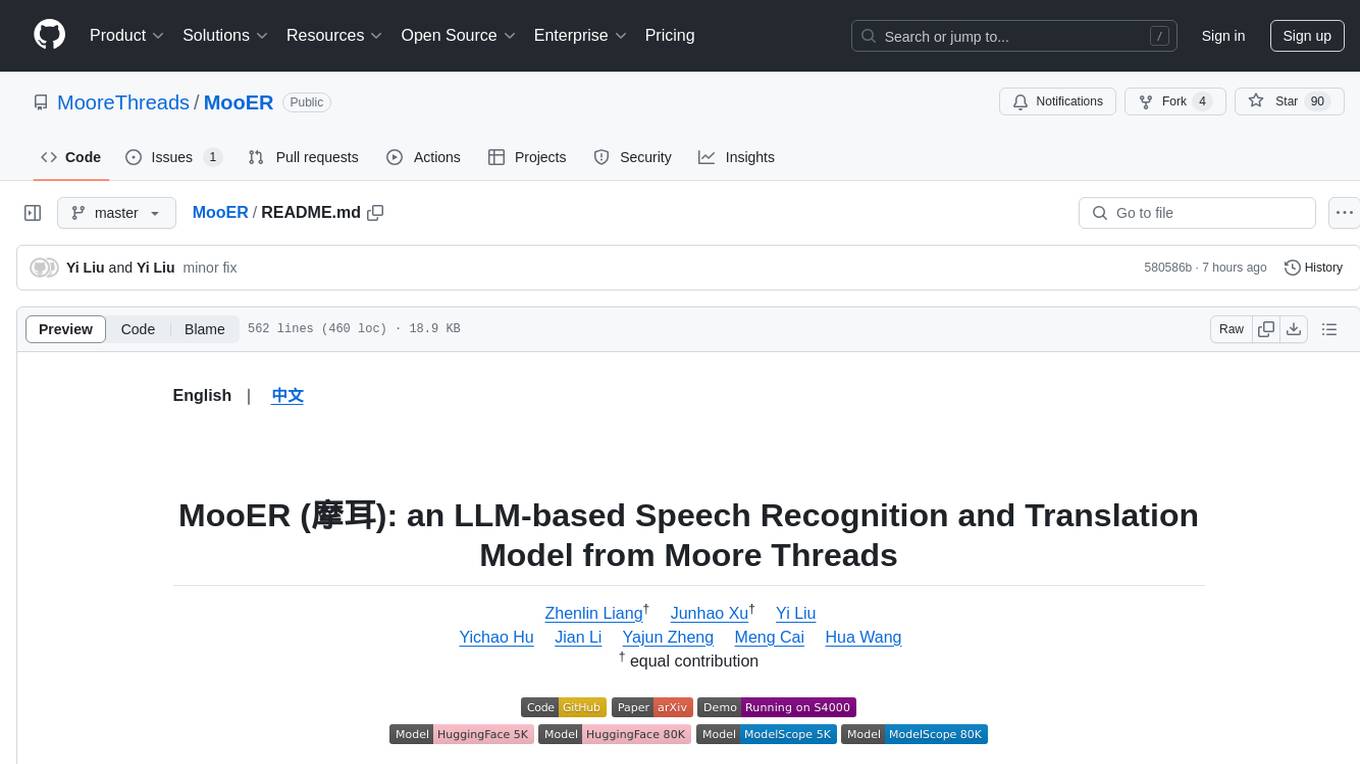
MooER
MooER (摩耳) is an LLM-based speech recognition and translation model developed by Moore Threads. It allows users to transcribe speech into text (ASR) and translate speech into other languages (AST) in an end-to-end manner. The model was trained using 5K hours of data and is now also available with an 80K hours version. MooER is the first LLM-based speech model trained and inferred using domestic GPUs. The repository includes pretrained models, inference code, and a Gradio demo for a better user experience.
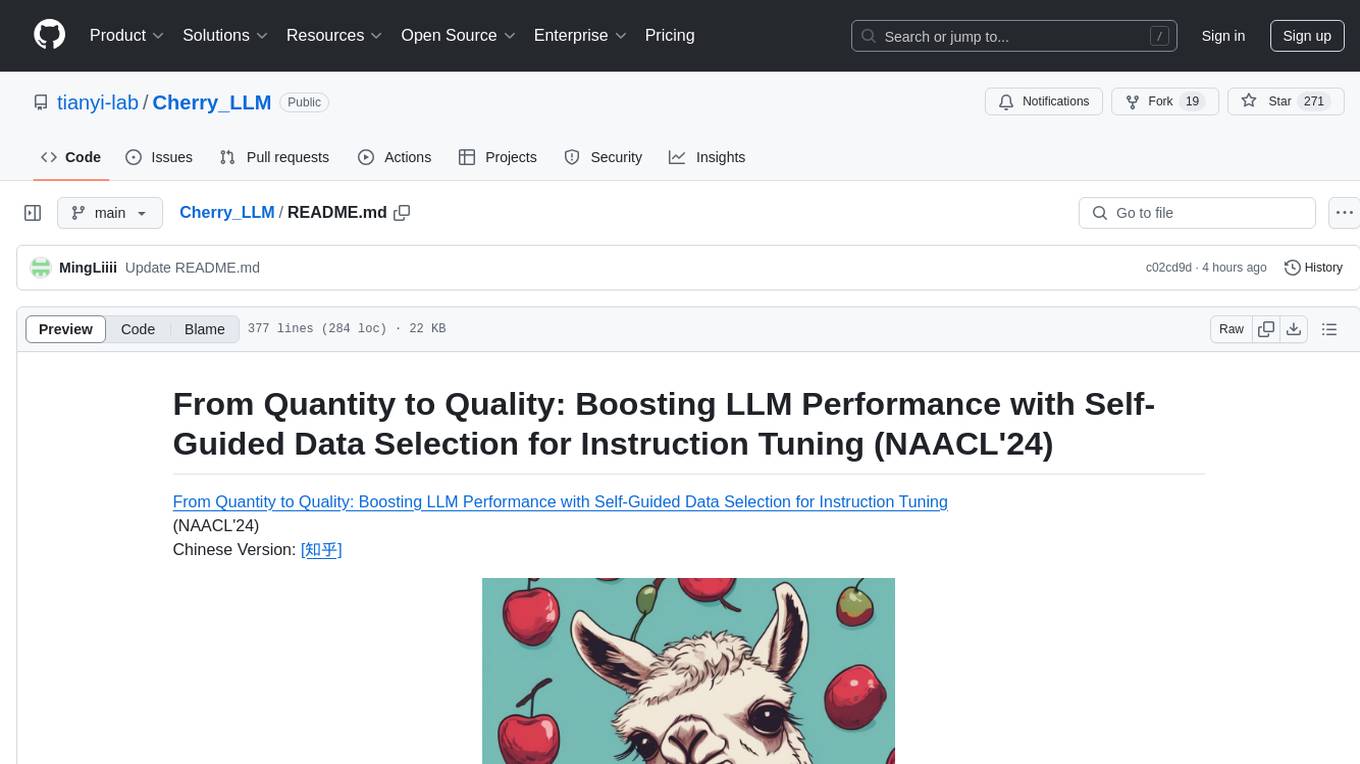
Cherry_LLM
Cherry Data Selection project introduces a self-guided methodology for LLMs to autonomously discern and select cherry samples from open-source datasets, minimizing manual curation and cost for instruction tuning. The project focuses on selecting impactful training samples ('cherry data') to enhance LLM instruction tuning by estimating instruction-following difficulty. The method involves phases like 'Learning from Brief Experience', 'Evaluating Based on Experience', and 'Retraining from Self-Guided Experience' to improve LLM performance.
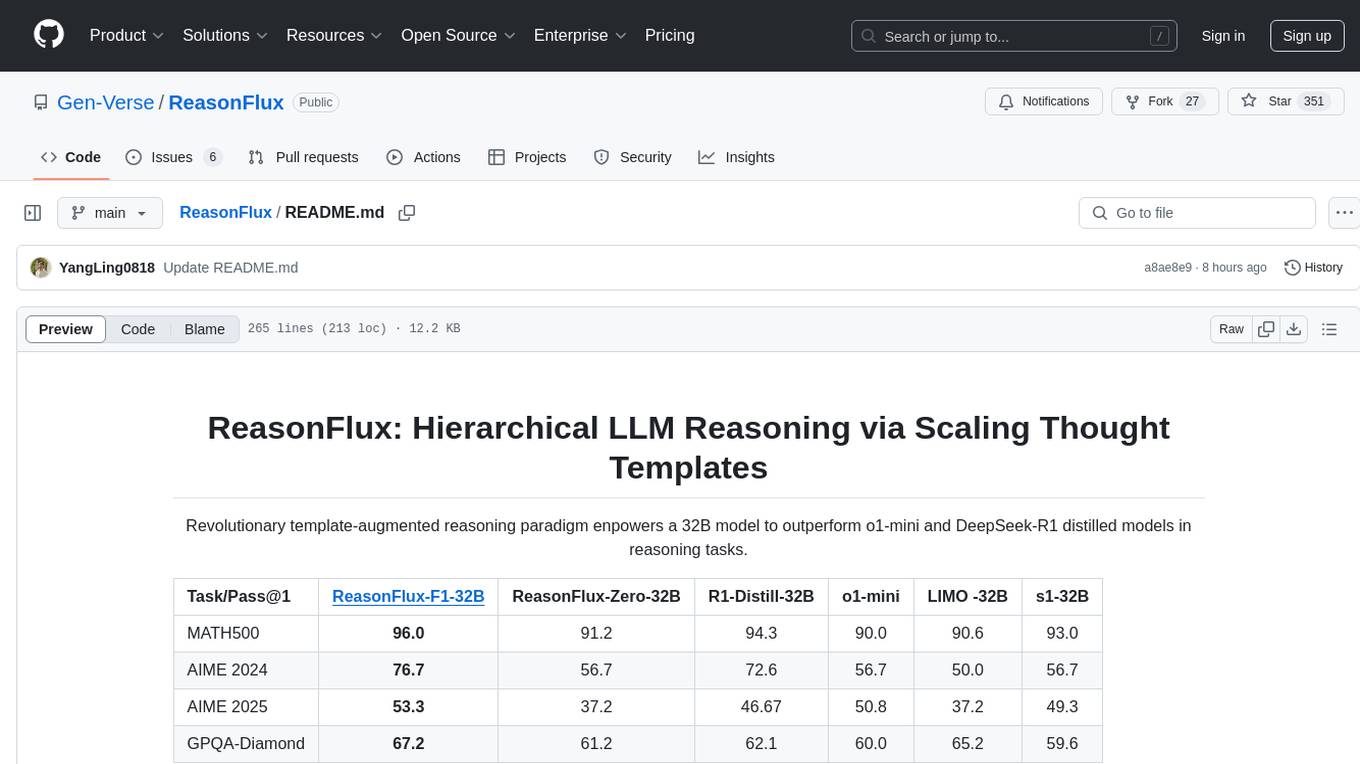
ReasonFlux
ReasonFlux is a revolutionary template-augmented reasoning paradigm that empowers a 32B model to outperform other models in reasoning tasks. The repository provides official resources for the paper 'ReasonFlux: Hierarchical LLM Reasoning via Scaling Thought Templates', including the latest released model ReasonFlux-F1-32B. It includes updates, dataset links, model zoo, getting started guide, training instructions, evaluation details, inference examples, performance comparisons, reasoning examples, preliminary work references, and citation information.
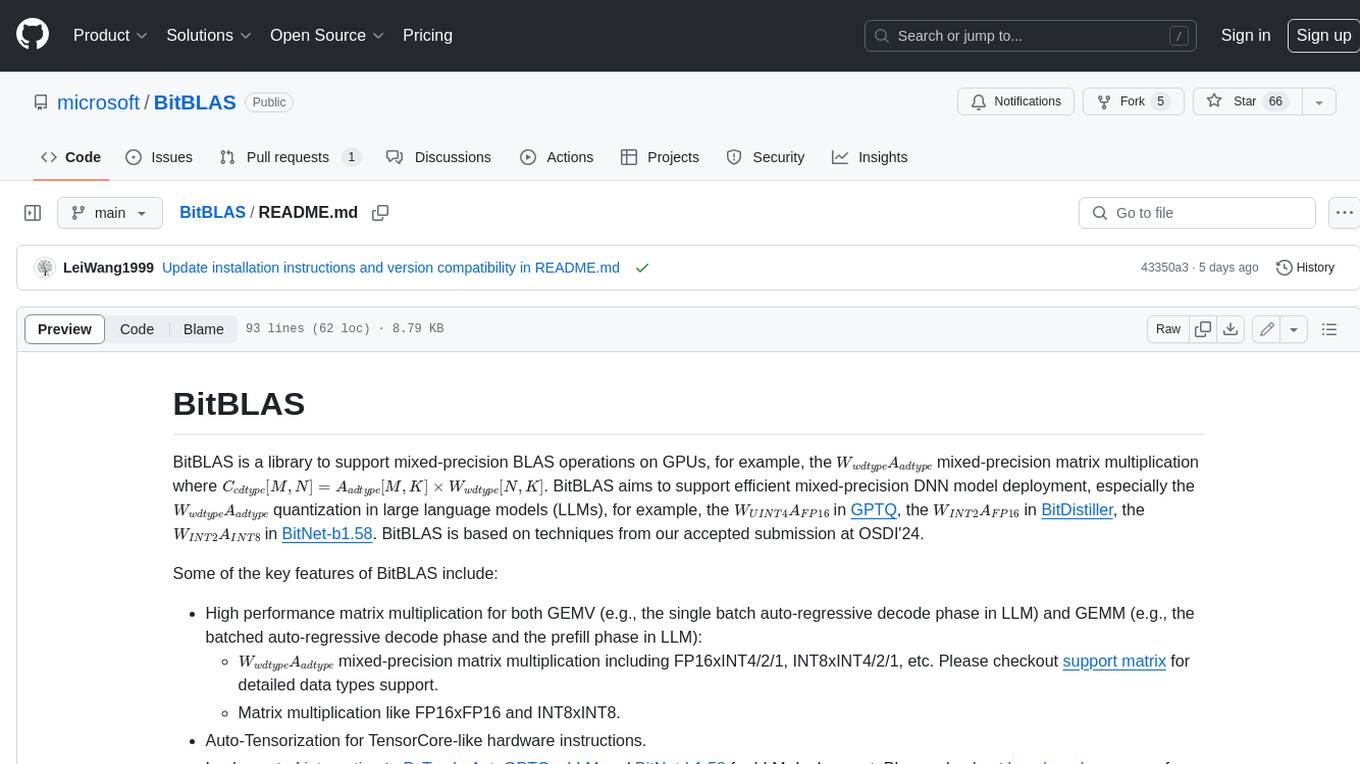
BitBLAS
BitBLAS is a library for mixed-precision BLAS operations on GPUs, for example, the $W_{wdtype}A_{adtype}$ mixed-precision matrix multiplication where $C_{cdtype}[M, N] = A_{adtype}[M, K] \times W_{wdtype}[N, K]$. BitBLAS aims to support efficient mixed-precision DNN model deployment, especially the $W_{wdtype}A_{adtype}$ quantization in large language models (LLMs), for example, the $W_{UINT4}A_{FP16}$ in GPTQ, the $W_{INT2}A_{FP16}$ in BitDistiller, the $W_{INT2}A_{INT8}$ in BitNet-b1.58. BitBLAS is based on techniques from our accepted submission at OSDI'24.
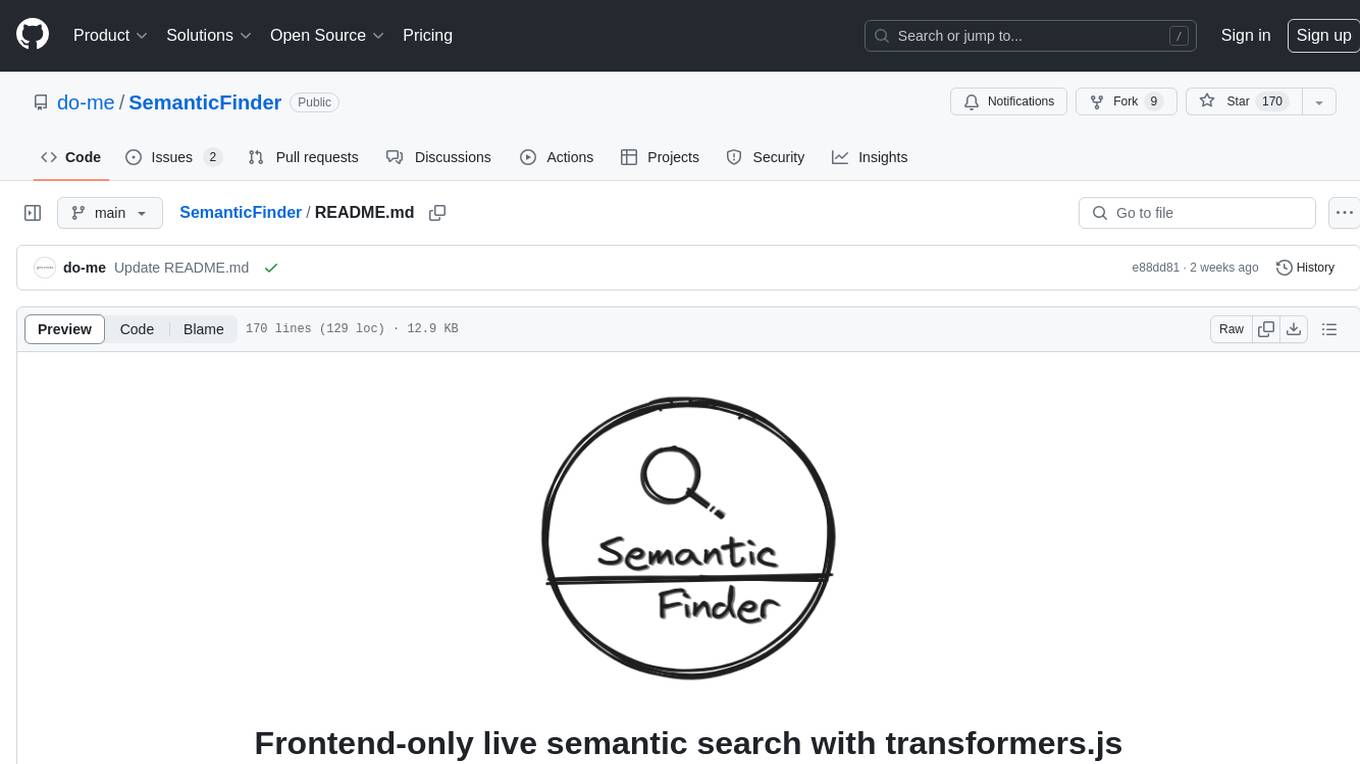
SemanticFinder
SemanticFinder is a frontend-only live semantic search tool that calculates embeddings and cosine similarity client-side using transformers.js and SOTA embedding models from Huggingface. It allows users to search through large texts like books with pre-indexed examples, customize search parameters, and offers data privacy by keeping input text in the browser. The tool can be used for basic search tasks, analyzing texts for recurring themes, and has potential integrations with various applications like wikis, chat apps, and personal history search. It also provides options for building browser extensions and future ideas for further enhancements and integrations.
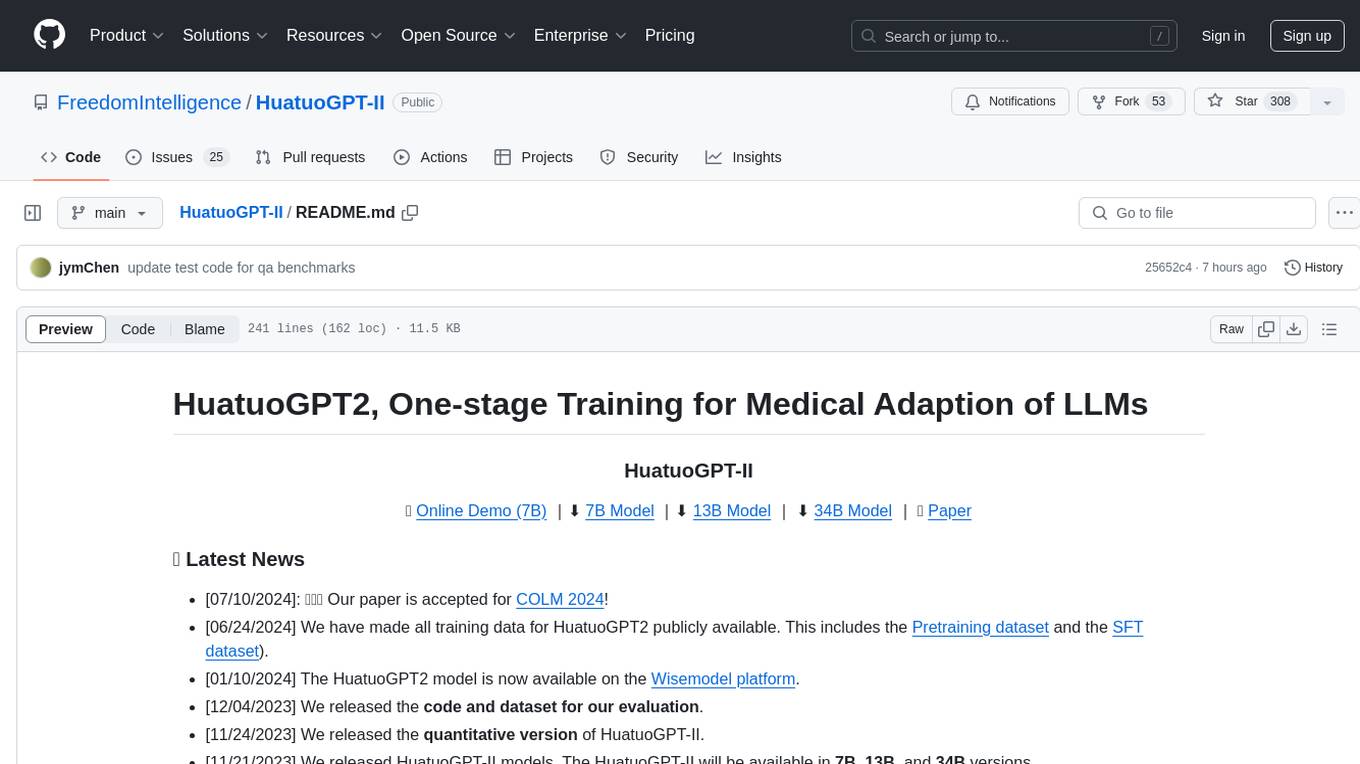
HuatuoGPT-II
HuatuoGPT2 is an innovative domain-adapted medical large language model that excels in medical knowledge and dialogue proficiency. It showcases state-of-the-art performance in various medical benchmarks, surpassing GPT-4 in expert evaluations and fresh medical licensing exams. The open-source release includes HuatuoGPT2 models in 7B, 13B, and 34B versions, training code for one-stage adaptation, partial pre-training and fine-tuning instructions, and evaluation methods for medical response capabilities and professional pharmacist exams. The tool aims to enhance LLM capabilities in the Chinese medical field through open-source principles.
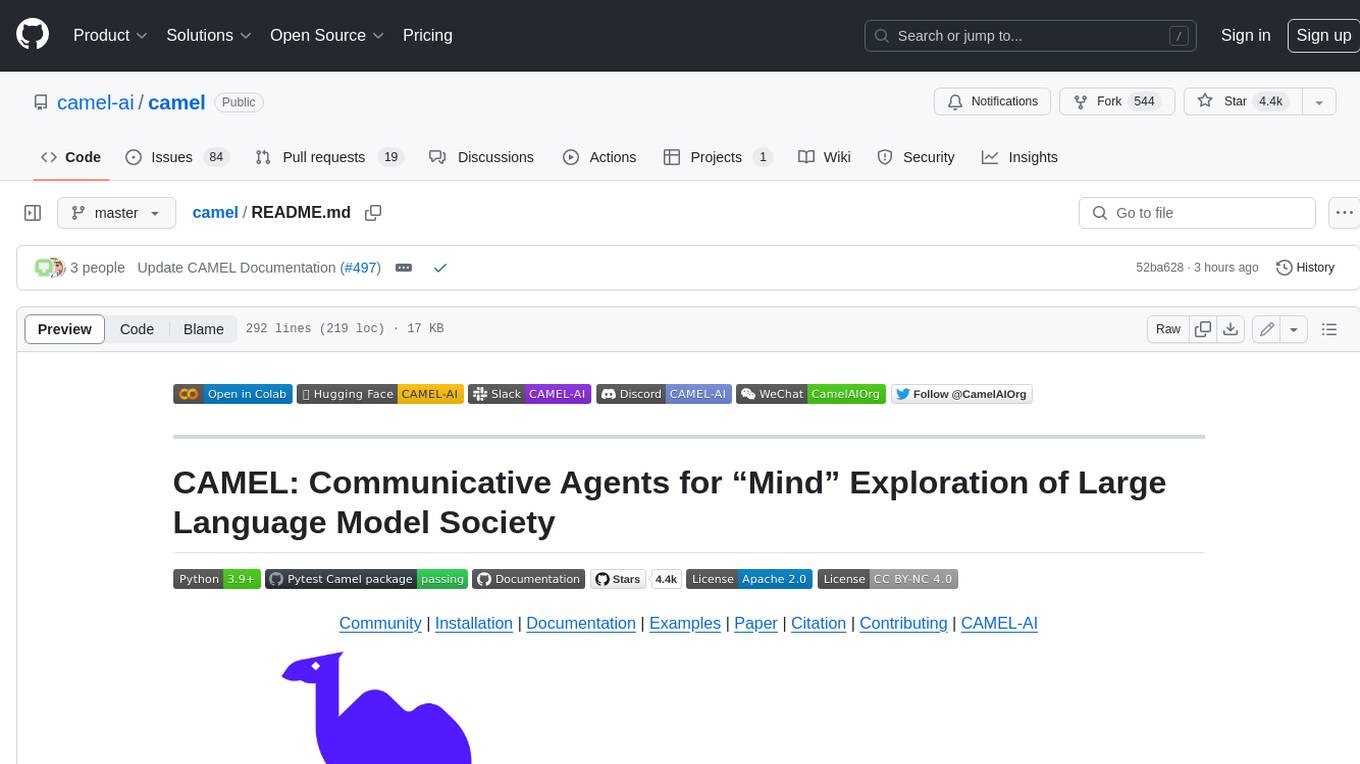
camel
CAMEL is an open-source library designed for the study of autonomous and communicative agents. We believe that studying these agents on a large scale offers valuable insights into their behaviors, capabilities, and potential risks. To facilitate research in this field, we implement and support various types of agents, tasks, prompts, models, and simulated environments.
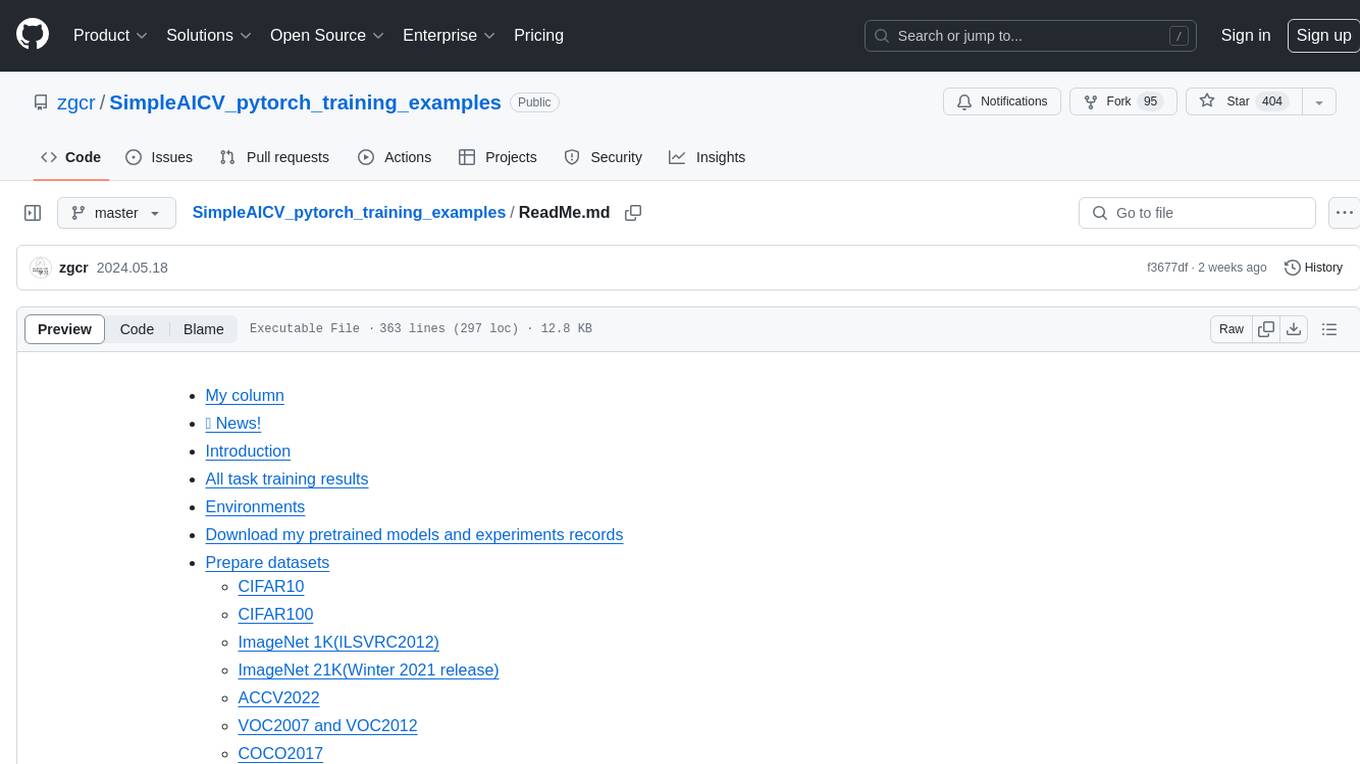
SimpleAICV_pytorch_training_examples
SimpleAICV_pytorch_training_examples is a repository that provides simple training and testing examples for various computer vision tasks such as image classification, object detection, semantic segmentation, instance segmentation, knowledge distillation, contrastive learning, masked image modeling, OCR text detection, OCR text recognition, human matting, salient object detection, interactive segmentation, image inpainting, and diffusion model tasks. The repository includes support for multiple datasets and networks, along with instructions on how to prepare datasets, train and test models, and use gradio demos. It also offers pretrained models and experiment records for download from huggingface or Baidu-Netdisk. The repository requires specific environments and package installations to run effectively.
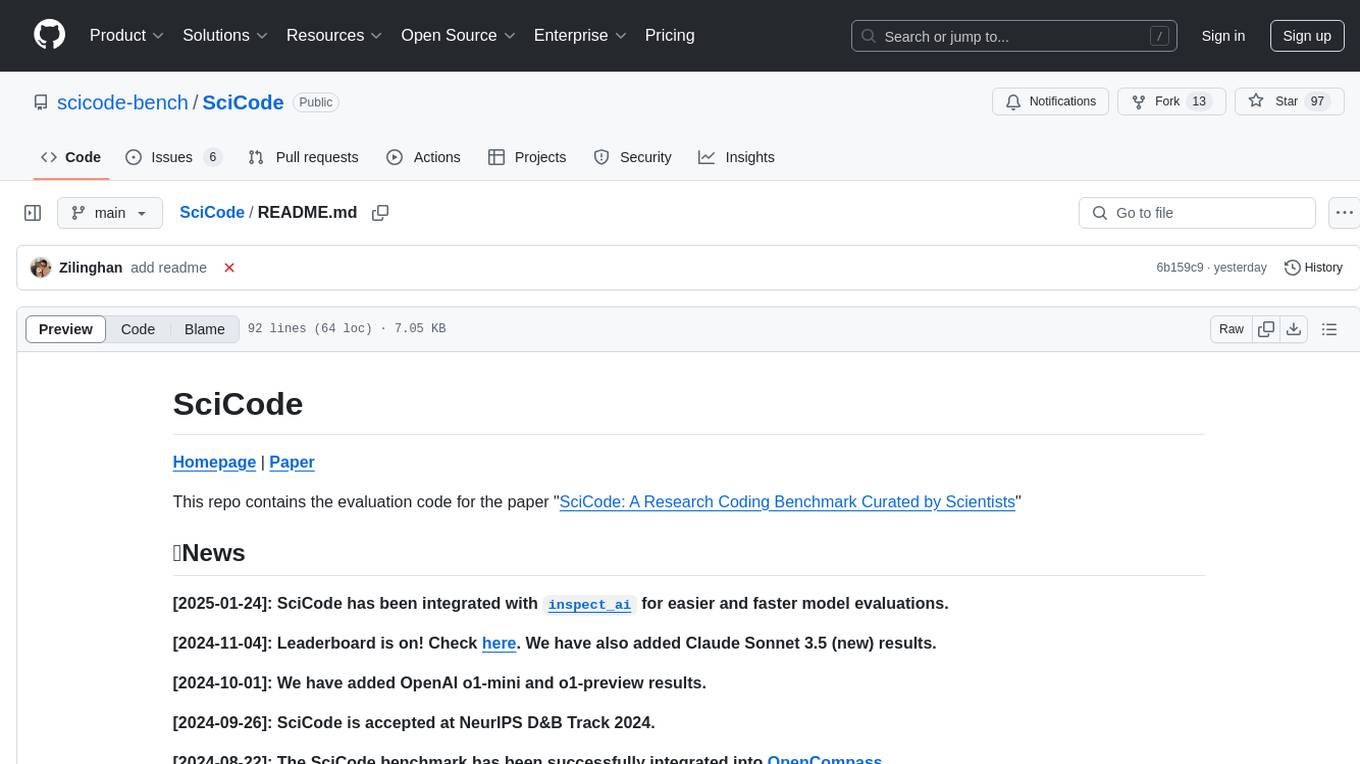
SciCode
SciCode is a challenging benchmark designed to evaluate the capabilities of language models (LMs) in generating code for solving realistic scientific research problems. It contains 338 subproblems decomposed from 80 challenging main problems across 16 subdomains from 6 domains. The benchmark offers optional descriptions specifying useful scientific background information and scientist-annotated gold-standard solutions and test cases for evaluation. SciCode demonstrates a realistic workflow of identifying critical science concepts and facts and transforming them into computation and simulation code, aiming to help showcase LLMs' progress towards assisting scientists and contribute to the future building and evaluation of scientific AI.
For similar tasks

qserve
QServe is a serving system designed for efficient and accurate Large Language Models (LLM) on GPUs with W4A8KV4 quantization. It achieves higher throughput compared to leading industry solutions, allowing users to achieve A100-level throughput on cheaper L40S GPUs. The system introduces the QoQ quantization algorithm with 4-bit weight, 8-bit activation, and 4-bit KV cache, addressing runtime overhead challenges. QServe improves serving throughput for various LLM models by implementing compute-aware weight reordering, register-level parallelism, and fused attention memory-bound techniques.
For similar jobs

weave
Weave is a toolkit for developing Generative AI applications, built by Weights & Biases. With Weave, you can log and debug language model inputs, outputs, and traces; build rigorous, apples-to-apples evaluations for language model use cases; and organize all the information generated across the LLM workflow, from experimentation to evaluations to production. Weave aims to bring rigor, best-practices, and composability to the inherently experimental process of developing Generative AI software, without introducing cognitive overhead.

LLMStack
LLMStack is a no-code platform for building generative AI agents, workflows, and chatbots. It allows users to connect their own data, internal tools, and GPT-powered models without any coding experience. LLMStack can be deployed to the cloud or on-premise and can be accessed via HTTP API or triggered from Slack or Discord.

VisionCraft
The VisionCraft API is a free API for using over 100 different AI models. From images to sound.

kaito
Kaito is an operator that automates the AI/ML inference model deployment in a Kubernetes cluster. It manages large model files using container images, avoids tuning deployment parameters to fit GPU hardware by providing preset configurations, auto-provisions GPU nodes based on model requirements, and hosts large model images in the public Microsoft Container Registry (MCR) if the license allows. Using Kaito, the workflow of onboarding large AI inference models in Kubernetes is largely simplified.

PyRIT
PyRIT is an open access automation framework designed to empower security professionals and ML engineers to red team foundation models and their applications. It automates AI Red Teaming tasks to allow operators to focus on more complicated and time-consuming tasks and can also identify security harms such as misuse (e.g., malware generation, jailbreaking), and privacy harms (e.g., identity theft). The goal is to allow researchers to have a baseline of how well their model and entire inference pipeline is doing against different harm categories and to be able to compare that baseline to future iterations of their model. This allows them to have empirical data on how well their model is doing today, and detect any degradation of performance based on future improvements.

tabby
Tabby is a self-hosted AI coding assistant, offering an open-source and on-premises alternative to GitHub Copilot. It boasts several key features: * Self-contained, with no need for a DBMS or cloud service. * OpenAPI interface, easy to integrate with existing infrastructure (e.g Cloud IDE). * Supports consumer-grade GPUs.

spear
SPEAR (Simulator for Photorealistic Embodied AI Research) is a powerful tool for training embodied agents. It features 300 unique virtual indoor environments with 2,566 unique rooms and 17,234 unique objects that can be manipulated individually. Each environment is designed by a professional artist and features detailed geometry, photorealistic materials, and a unique floor plan and object layout. SPEAR is implemented as Unreal Engine assets and provides an OpenAI Gym interface for interacting with the environments via Python.

Magick
Magick is a groundbreaking visual AIDE (Artificial Intelligence Development Environment) for no-code data pipelines and multimodal agents. Magick can connect to other services and comes with nodes and templates well-suited for intelligent agents, chatbots, complex reasoning systems and realistic characters.

